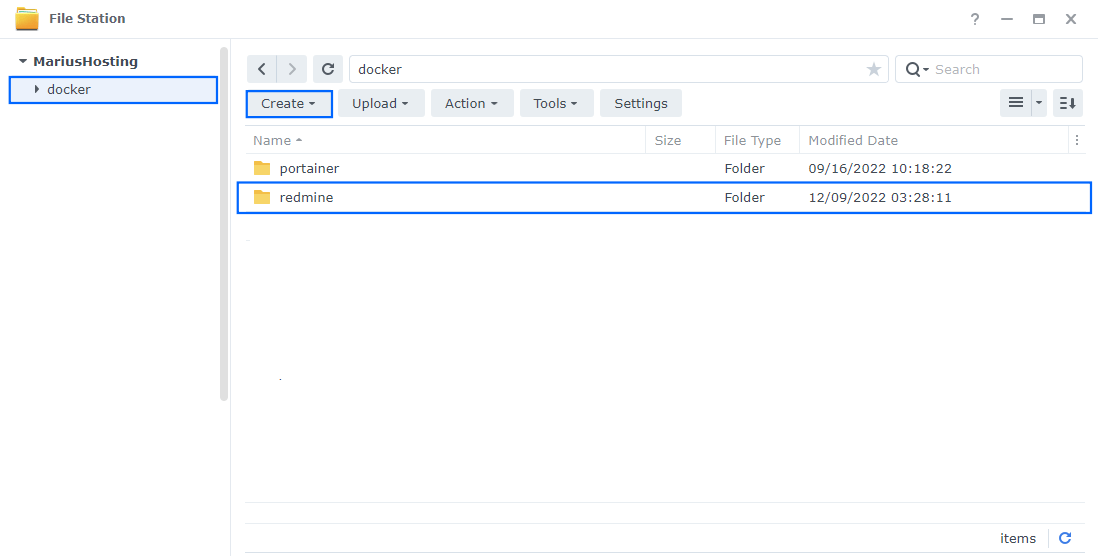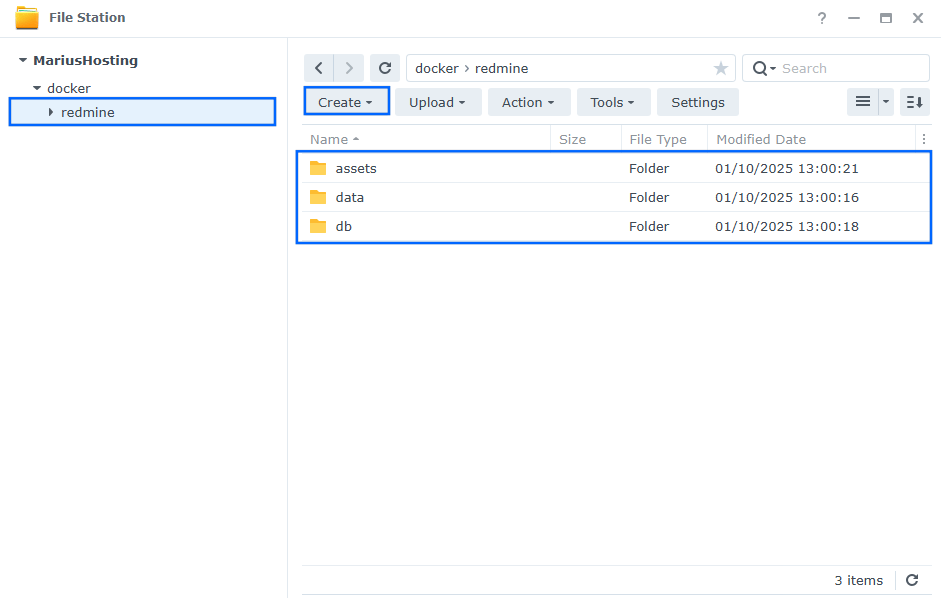
Redmine is a free and open source, web-based project management and issue tracking tool. It allows users to manage multiple projects and associated subprojects. It features per project wikis and forums, time tracking, and flexible, role-based access control. In this step by step guide I will show you how to install Redmine on your Synology NAS using Docker & Portainer.
This guide works perfectly with the latest Redmine 6.1.0 release.
STEP 1
Please Support My work by Making a Donation.
STEP 2
Install Portainer using my step by step guide. If you already have Portainer installed on your Synology NAS, skip this STEP. Attention: Make sure you have installed the latest Portainer version.
STEP 3
Go to File Station and open the docker folder. Inside the docker folder, create one new folder and name it redmine. Follow the instructions in the image below.
Note: Be careful to enter only lowercase, not uppercase letters.

STEP 4
Now create two new folders inside the redmine folder that you created at STEP 3 and name them assets, data, db. Follow the instructions in the image below.
Note: Be careful to enter only lowercase, not uppercase letters.

STEP 5
Log into Portainer using your username and password. On the left sidebar in Portainer, click on Home then Live connect. Follow the instructions in the image below.

On the left sidebar in Portainer, click on Stacks then + Add stack. Follow the instructions in the image below.

STEP 6
In the Name field type in redmine. Follow the instructions in the image below.
services:
db:
image: mariadb:11.4-noble #LTS Long Time Support Until May 29, 2029.
container_name: Redmine-DB
hostname: redmine-db
security_opt:
- no-new-privileges:false
environment:
TZ: Europe/Bucharest
MYSQL_ROOT_PASSWORD: superstrangepass
MYSQL_DATABASE: redmine
MYSQL_USER: redmineuser
MYSQL_PASSWORD: redminepass
volumes:
- /volume1/docker/redmine/db:/var/lib/mysql:rw
restart: on-failure:5
redmine:
image: redmine:latest
container_name: Redmine
hostname: redmine
security_opt:
- no-new-privileges:true
healthcheck:
test: wget --no-verbose --tries=1 --spider http://localhost:3000/ || exit 1
user: 1026:100
environment:
REDMINE_DB_MYSQL: redmine-db
REDMINE_DB_DATABASE: redmine
REDMINE_DB_USERNAME: redmineuser
REDMINE_DB_PASSWORD: redminepass
volumes:
- /volume1/docker/redmine/data:/usr/src/redmine/files:rw
- /volume1/docker/redmine/assets:/usr/src/redmine/public/assets:rw
ports:
- 3434:3000
restart: on-failure:5
depends_on:
db:
condition: service_started
Note: Before you paste the code above in the Web editor area below, change the value for TZ. (Select your current Time Zone from this list.)
Note: Before you paste the code above in the Web editor area below, change the value numbers for user with your own UID and GID values. (Follow my step by step guide on how to do this.) 1026 is my personal UID value and 100 is my personal GID value. You have to type in your own values.

STEP 7
Scroll down on the page until you see a button named Deploy the stack. Click on it. Follow the instructions in the image below. The installation process can take up to a few minutes. It will depend on your Internet speed connection.

STEP 8
If everything goes right, you will see the following message at the top right of your screen: “Success Stack successfully deployed“.

STEP 9
🟢Please Support My work by Making a Donation. Almost 99,9% of the people that install something using my guides forget to support my work, or just ignore STEP 1. I’ve been very honest about this aspect of my work since the beginning: I don’t run any ADS, I don’t require subscriptions, paid or otherwise, I don’t collect IPs, emails, and I don’t have any referral links from Amazon or other merchants. I also don’t have any POP-UPs or COOKIES. I have repeatedly been told over the years how much I have contributed to the community. It’s something I love doing and have been honest about my passion since the beginning. But I also Need The Community to Support me Back to be able to continue doing this work.
STEP 10
Please wait approximately 5 minutes for the installation to be completed or you will get a blank page if you try to connect too soon. The installation process can take up to a few seconds/minutes. It will depend on your Internet speed connection. Now open your browser and type in http://Synology-ip-address:3434 Click Sign in at the top right of the page. Follow the instructions in the image below.

STEP 11
Type in the default Username and Password, then click Login.

STEP 12
You will be prompted to change the current admin password with your own password. Follow the instructions in the image below.

STEP 13
After you click Apply on STEP 12 you will be prompted to change your account information. Change it, then click Save. Follow the instructions in the image below.

Enjoy Redmine!
If you encounter issues by using this container, make sure to check out the Common Docker issues article.
Note: If you want to run the Redmine container over HTTPS, check out my guide on How to Run Docker Containers Over HTTPS.
Note: Can I run Docker on my Synology NAS? See the supported models.
Note: How to Back Up Docker Containers on your Synology NAS.
Note: Find out how to update the Redmine container with the latest image.
Note: How to Free Disk Space on Your NAS if You Run Docker.
Note: How to Schedule Start & Stop For Docker Containers.
Note: How to Activate Email Notifications.
Note: How to Add Access Control Profile on Your NAS.
Note: How to Change Docker Containers Restart Policy.
Note: How to Use Docker Containers With VPN.
Note: Convert Docker Run Into Docker Compose.
Note: How to Clean Docker.
Note: How to Clean Docker Automatically.
Note: Best Practices When Using Docker and DDNS.
Note: Some Docker Containers Need WebSocket.
Note: Find out the Best NAS Models For Docker.
Note: Activate Gmail SMTP For Docker Containers.
This post was updated on Wednesday / November 12th, 2025 at 2:54 AM
